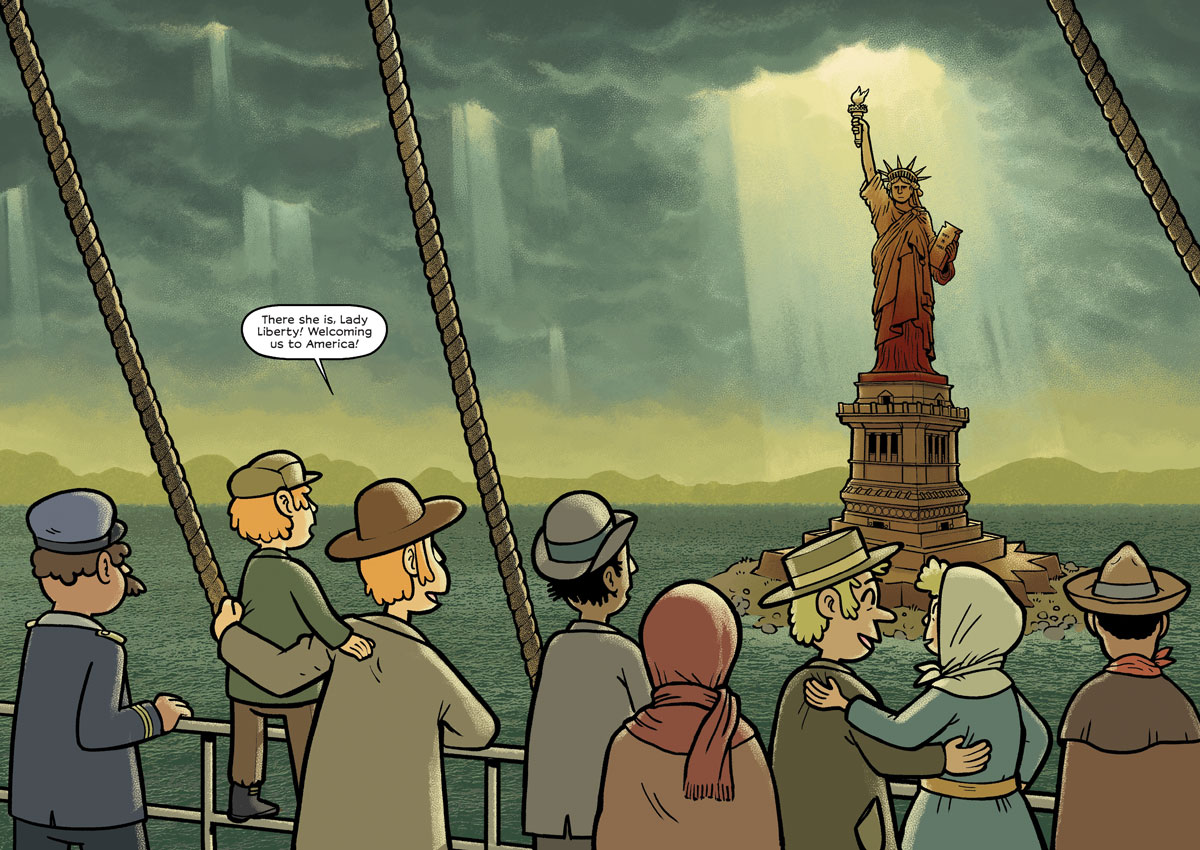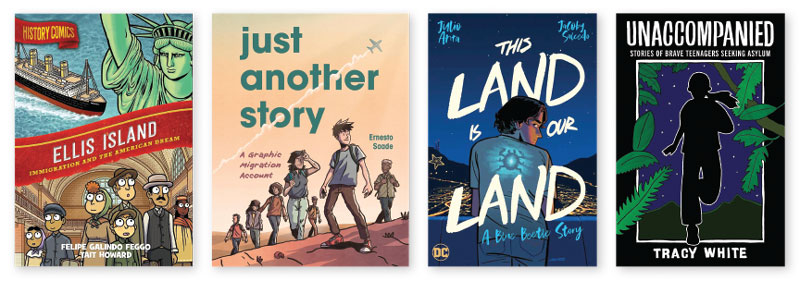Coming Home: Graphic Novels About the Immigration Experience | Stellar Panels
Seven new graphic novels, both fiction and nonfiction, that depict the immigration experience.
 |
History Comics: Ellis Island: Immigration and the American Dream (Feggo) ©2025 by Tait Howard. |
Immigration is a lived experience for millions of Americans and their family members. Graphic novels such as Robin Ha’s Almost American Girl, Tina Cho’s The Other Side of Tomorrow, and Pedro Martín’s Mexikid illustrate the complexity of immigration, depicting the reasons migrants leave their home countries, the dangers they face on the journey, their adjustments to a new country, and the challenges the younger generation faces when they return to their parents’ country and feel like strangers in a place others call home.
Here are seven new graphic novels, fiction and nonfiction, that touch on these issues in different ways.

ANTA, Julio. Speak Up, Santiago!: A Hillside Valley Graphic Novel. illus. by Gabi Mendez. Mar. 2025. Random House Graphic.
Gr 3-7–This graphic novel examines a phenomenon familiar to many second-generation immigrants: although his father is Colombian, 12-year-old Santiago grew up speaking English and only recently began learning Spanish. His family sends him to visit his grandmother so he can practice his Spanish with her, and when he arrives, he quickly finds a group of bilingual friends who invite him to join their soccer team. Santiago is proud of the progress he is making in Spanish, but loses confidence when he feels others are being patronizing or joking behind his back. While that problem is universal, the book also reflects on the challenges that face children who are not fluent in their parents’ language. Much of the dialogue is rendered in both Spanish and English. Mendez keeps the art simple, with lively characters and space for all those word balloons. This book is the first in a series set in a Latinx enclave in New York’s Hudson Valley.
CHAN, Ruth. Uprooted: A Memoir About What Happens When Your Family Moves Back. illus. by author. Roaring Brook. 2024.
Gr 3-7–Ruth is enjoying her life as a middle schooler in Toronto, so she’s apprehensive when her parents announce the family is moving to Hong Kong. It’s a homecoming for her parents, but to Ruth, it’s a trip to a strange land. The adjustment is rough, particularly in the beginning. Ruth’s father is often away for work, and her mother, who is enjoying being reunited with family and friends, has little time for her daughter. Ruth also finds family gatherings intimidating. However, even when her parents are distracted, they are caring and supportive. In his bedtime talks, Ruth’s father tells the story of his birth and the hardships his family endured fleeing their village during the Sino-Japanese war. These stories, rendered in sepia tones, reemphasize the importance of family bonds.
CHANG, Cindy. How to Draw a Secret. illus. by author. HarperCollins/Allida. Feb. 2025.
Gr 3-7–When middle schooler Cindy flies to Taiwan with her mother and two older sisters for her grandmother’s funeral, she is also heading for a reunion with her father, who has been living there for four years. That’s the titular secret: Cindy’s mother doesn’t want anyone to know her dad has been living overseas and apart from the family, so Cindy hasn’t told even her best friends. As the story progresses, more family secrets come out. Chang does a masterful job telling the story, showing Cindy’s mother and sisters enjoying the familiar sights and foods of Taiwan, then depicting their reactions as the girls learn shocking news, and they process it as a family. As the youngest sibling with few memories of previous family visits to Taiwan, Cindy sometimes feels left out and has trouble with aspects of life there, such as the rituals of a Buddhist funeral. Her family speaks English and Chinese, and the grown-ups also speak Taiwanese, which the girls call their “secret language” because they don’t understand it. The throughline in this story is a homework assignment: Cindy is supposed to be working on an art project that depicts her family while she’s on the trip, and her drawings help her process her feelings during this trying time.

FEGGO, Felipe Galindo. History Comics: Ellis Island: Immigration and the American Dream. illus. by Tait Howard. First Second. Jan. 2025.
Gr 4-9–Feggo tells the story of Ellis Island from different angles, including the history of the island, the experiences of immigrants, and its status as a mythical gateway to the United States. When Hurricane Sandy knocks out power to New York City, an Ellis Island park ranger, Amie, and her son take refuge with their upstairs neighbors, a Latinx family. As the storm rages, Amie tells stories about the history of the island and her own family’s journey from Ireland. José, a neighbor, explains that he is from a region that was once Mexico and is now part of the United States. Instead of his family crossing the border, he says, “the border crossed them.” The book covers many topics in short order to present a solid, well-rounded story of Ellis Island and the people who passed through—as well as some of those who didn’t, such as enslaved people, those who went through other ports, and those who were turned back.
SAADE, Ernesto. Just Another Story: A Graphic Migration Account. illus. by author. Graphic Universe. 2024.
Gr 7 Up–Saade tells the story of the journey that his cousin Carlos made from El Salvador to the United States at the age of 19. A conversation between the two, 10 years later, frames the tale, so we know the story will have a happy ending. That takes the edge off the scary parts, as Carlos and his mother face bandits, make a perilous river crossing, and escape from kidnappers. The storytelling is brisk and the visuals simple and easy to grasp. What sets this book apart is that the characters feel grounded and real. Carlos talks to the people around him, connecting with the other migrants and with some of the coyotes—people who guide migrants across the border for money—whom Carlos finds are ruthless because they must be. The bandits and narco gangs who prey on migrants are as harsh and potentially deadly as the terrain they travel through. The framing conversation enriches the story, as Carlos reflects on his younger self, and Ernesto’s hassle-free flight from El Salvador to Los Angeles stands in stark contrast to his cousin’s journey. Among many stories of migration, this stands out, combining a compelling narrative with fluid artwork and a thoughtful approach.
ANTA, Julio. This Land Is Our Land: A Blue Beetle Story. illus. by Jacoby Salcedo. DC. 2024.
Gr 8-12—High schooler Jaime Reyes would rather gaze at the stars than engage with what’s going on in his community. But when his friends learn that their classmate Riley has joined a white supremacist group, Jaime reluctantly joins in investigating. Meanwhile, his father’s garage business is suffering because the border with Mexico has been closed and he can’t get the parts he needs. To top it off, the mysterious blue fossil that Jaime found in the desert attaches itself to his back and starts talking to him. In fact, the blue scarab is not a fossil at all, but a bit of technology from aliens who are planning to come to Earth to resolve all its problems. Jaime is the chosen one who will prepare the way, and the scarab gives him a battle suit to help. Like all superheroes, Jaime first struggles to control his powers, then uses them for selfish reasons, flying across the border to fetch the parts his father needs. When he realizes that the aliens plan to invade Earth rather than help it—and that he is not the chosen one, just a random person who found the scarab—he must scramble to stop the invasion. Superhero action leavened with high school drama combine to make the story feel grounded.
WHITE, Tracy. Unaccompanied: Stories of Brave Teenagers Seeking Asylum. illus. by author. Street Noise. 2023.
Gr 10 Up–This carefully documented book tells four stories of teenagers who arrived in the United States as unaccompanied minors. Vilma is fleeing her abusive father in Guatemala; Rosa has to leave Honduras because her boyfriend, a gang member, is threatening to kill her; Ricardo and Karen realize they cannot stay in El Salvador after local gangs leave a pig’s head at their door; and Fanta, married at 12 to a much older man, leaves her children behind in her native Guinea to escape beatings and rape. Each follows a different path, showing the many ways immigrants travel to the United States and begin their next journey through the courts and social service systems. The steps of the process are laid out simply, and while the teens encounter obstacles, they have lawyers and social worker advocates, which is not typically the case for immigrant teens in real life. White approaches serious topics, including rape, incest, family violence, and self-harm, in a straightforward way, focusing on the teens and their experiences and eschewing explicit depictions. The simple art uses black, white, and gray, often modestly sketching in a background and other times adding rich details. The book has source notes, a glossary, further reading suggestions, and discussion questions.

RELATED
The job outlook in 2030: Librarians will be in demand
The job outlook in 2030: Librarians will be in demand
ALREADY A SUBSCRIBER? LOG IN
We are currently offering this content for free. Sign up now to activate your personal profile, where you can save articles for future viewing






Add Comment :-
Be the first reader to comment.
Comment Policy:
Comment should not be empty !!!